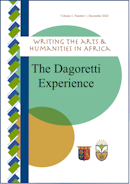The Inside and the outside : identity performance in the context of social research
Abstract
Identities are an irrevocable component of social life. They help us better know ourselves and others, enabling communication, mutual understanding, and social cohesion. We assume different identities in our day-to-day lives, performing the ‘self’ depending on whether we are being observed, and who is observing us. This ‘on stage’ and ‘backstage’ behaviour corresponds to public ‘outer’ and private ‘inner’ dimensions of self, with the outer self observing the prescribed social norms and behaviour despite what the inner self may think and feel. When two groups interact, alternative realities come face to face, and multiple ‘inside’ and ‘outside’ selves emerge, with participants performing the roles they believe fit the context. This article examines this identity performance and the ‘inside-outside’ positionality in the context of social research. Reflecting on interactions and activities undertaken during a collaborative North-South research module, I posit that research engagements would do well to implement actions that diminish the perceived power distance between the parties involved.
References
Alfrey, K. L., Waters, K. M., Condie, M., & Rebar, A. L. (2023). The Role of Identity in Human Behavior Research: A Systematic Scoping Review. Identity, 23(3), 208–223.
Burke, P. J., & Stets, J. E. (2023). Identity Theory: Revised and Expanded (2nd ed.). New York: Oxford University Press.
Choquez-Millan, M. F., Lechtape, C. L., Löhr, K., Schröter, B., & Graef, F. (2024). Uncovering power asymmetries in North-South research collaborations – An example from sustainability research in Tanzania. Futures, 156.
Goffman, E. (1956). The Presentation of Self in Everyday Life (Monograph No. 2 ed.). University of Edinburgh Social Sciences Research Centre.
Greenwood, D. (1982). Cultural "Authenticity". Cultural Survival Quarterly, 6(3), 27-28.
Rokach, A. (2020). Belonging, Togetherness and Food Rituals. Open Journal of Depression, 9(4), 77-85.
Spreckels, J., & Kotthoff, H. (2007). Communicating Identity in Intercultural Communication. In H. Kotthoff, & H. Spencer-Oatey (Eds.), Handbook of Intercultural Communication (pp. 415–19). Berlin: Mouton de Gruyter.
Tobore, T. O. (2023). On power and its corrupting effects: the effects of power on human behavior and the limits of accountability systems. Communicative & integrative biology, 16(1), 2246793.
Wilshire, B. (1982). The Limits of Appearance. In Role Playing and Identity: The Limits of Theatre as Metaphor (pp. 282-296). Bloomington: Indiana University Press.
Yep, G. A. (2002). My Three Cultures: Navigating the Multicultural Identity Landscape. In J. N. Martin, L. A. Flores, & T. K. Nakayama (Eds.), Intercultural Communication: Experiences and Contexts (p. 61). Boston: McGraw-Hill.
Downloads
Published
Issue
Section
License
Copyright (c) 2024 Waithera Kibuchi

This work is licensed under a Creative Commons Attribution 4.0 International License.

